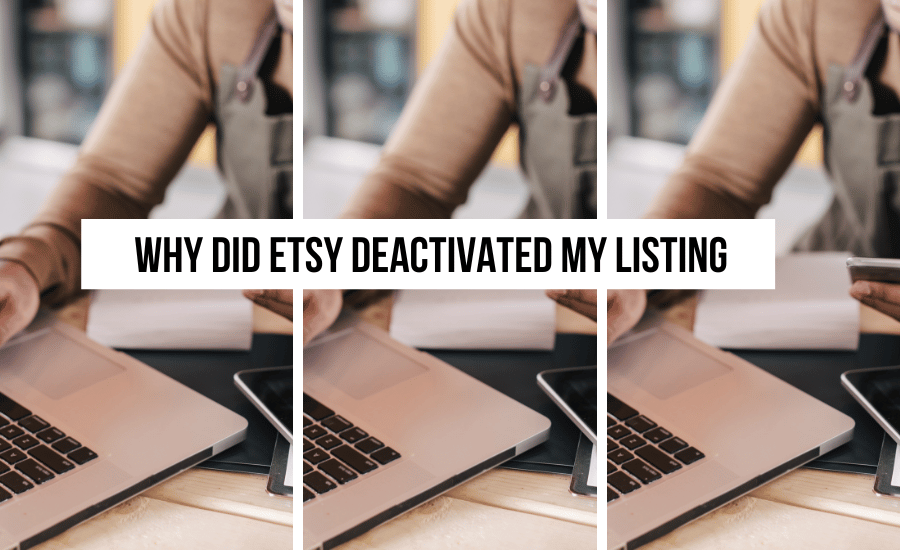If you are an Etsy seller, you know the feeling of excitement when you finally post a new listing. However, that excitement can quickly turn to frustration if you receive a notification that your listing has been deactivated. So, why did Etsy deactivate your listing? There are a variety of reasons why Etsy may decide to take down a listing, ranging from infringement on intellectual property rights to violating Etsy’s policies.
As a seller, it’s crucial to understand these reasons and take steps to avoid them in the future. In this article, we’ll explore some of the most common reasons why Etsy deactivates listings and provide tips on how you can avoid these issues and keep your shop running smoothly. So, whether you’re a seasoned seller or just starting out on Etsy, keep reading to learn more about why your listing may have been deactivated and how to prevent it from happening again.

This blog post is all about why did Etsy deactivate my listing.
Home > Etsy Biz > Why Did Etsy Deactivate My Listing
DISCLOSURE: This is a sponsored post. Through my links, I may receive a commission if you decide to make purchases at no cost for yourself! Check out our disclaimer for more info on how it works.
Ready to embark on your Etsy business journey but unsure of where to begin? Join our free masterclass, where we empower you to start, manage, and scale your Etsy business into a full-time income. With our guidance, 9,000+ individuals have found success, even without a social media presence or email list. Step into the world of Etsy entrepreneurship, and let us guide you to success. Join us now!
Table of contents
- Reasons Why Did Etsy Deactivate My Listing
- Common Mistakes That Result In Deactivated Listings
- How To Avoid Getting Your Listing Deactivated
- What To Do If Your Listing Is Deactivated
- Etsy’s Appeal Process
- Preventing Future Deactivations
- Conclusions: Why Did Etsy Deactivate My Listing?
- Ready To Scale Your Etsy Business Into A Full-Time Income?
- New On The Blog
Reasons Why Did Etsy Deactivate My Listing
There are a variety of reasons why Etsy may choose to deactivate a listing. Some of the most common reasons include:
1. Intellectual property infringement
One of the most common reasons why Etsy deactivates listings is because of intellectual property infringement. This can include using copyrighted images or text without permission, selling items that infringe on someone else’s patent or trademark, or selling counterfeit items. If Etsy receives a complaint about your listing from the copyright or trademark owner, they may choose to deactivate it.
2. Violating Etsy’s policies
Etsy has a set of policies that all sellers must follow. These policies cover everything from what can be sold on the site to how sellers should communicate with buyers. If you violate any of these policies, Etsy may choose to deactivate your listing. Some common policy violations include selling prohibited items, using inappropriate language in your listings, or engaging in abusive behavior towards buyers or other sellers.
3. Poor quality or inaccurate listings
Etsy wants to ensure that buyers have a positive experience when shopping on the site. This means that they may choose to deactivate listings that are of poor quality or that contain inaccurate information. For example, if your listing includes blurry or low-quality photos, or if the description doesn’t accurately reflect the item being sold, Etsy may choose to deactivate it.
4. Non-compliance with regulations
Etsy is required to comply with various laws and regulations, and they expect their sellers to do the same. If you’re selling items that are regulated, such as food or cosmetics, you may need to meet certain requirements in order to sell them on Etsy. If you fail to comply with these regulations, your listings may be deactivated.
Common Mistakes That Result In Deactivated Listings
Now that you know some of the reasons why Etsy may deactivate a listing, let’s take a closer look at some of the common mistakes that sellers make that can result in deactivated listings.
1. Using copyrighted images or text without permission
If you’re using images or text that you didn’t create yourself, it’s important to make sure that you have permission to use them. This includes images that you find online, as well as images or text that you may have purchased from someone else. If you use copyrighted material without permission, you run the risk of having your listing deactivated.
2. Selling prohibited items
Etsy has a list of prohibited items that cannot be sold on the site. This includes items that are illegal or dangerous, as well as items that infringe on someone else’s intellectual property rights. If you’re not sure whether an item is allowed on Etsy, it’s important to check the site’s policies before posting a listing.
3. Providing inaccurate information in your listings
It’s important to make sure that your listings are accurate and truthful. This includes providing accurate descriptions of your items, as well as ensuring that your photos accurately represent the item being sold. If you provide inaccurate information in your listings, Etsy may choose to deactivate them.
4. Failing to comply with regulations
As mentioned earlier, if you’re selling regulated items, it’s important to make sure that you’re meeting all of the necessary requirements. This may include obtaining permits or licenses, or ensuring that your items meet certain safety standards. If you fail to comply with these regulations, your listings may be deactivated.
How To Avoid Getting Your Listing Deactivated
Now that you know some of the common mistakes that can result in deactivated listings, let’s take a look at some tips for avoiding these issues in the future.
1. Only use images and text that you have permission to use
If you’re not sure whether you have the right to use an image or text, it’s best to err on the side of caution and assume that you don’t. You can either create your own images and text, or purchase them from a reputable source that provides a license to use them.
2. Familiarize yourself with Etsy’s policies
Etsy has a list of policies that all sellers must follow. It’s important to read through these policies and make sure that you understand them. If you’re not sure about something, don’t hesitate to reach out to Etsy’s customer support team for clarification.
3. Provide accurate information in your listings
Make sure that your listings are accurate and truthful. This includes providing clear and detailed descriptions of your items, as well as ensuring that your photos accurately represent the item being sold. If you’re not sure about something, do some research or reach out to an expert for help.
4. Comply with all applicable regulations
If you’re selling regulated items, familiarize yourself with the laws and regulations that apply to your products. Make sure that you’re meeting all of the necessary requirements, such as obtaining permits or licenses, or ensuring that your items meet certain safety standards.
What To Do If Your Listing Is Deactivated
If one or more of your listings has been deactivated, don’t panic. Here are some steps you can take to get your listings back up and running:
1. Review the reason for deactivation
Etsy should provide you with a reason for why your listing was deactivated. Review this reason carefully to determine what you need to do to fix the issue.
2. Make the necessary changes
Once you know why your listing was deactivated, make the necessary changes to ensure that it complies with Etsy’s policies and regulations. This may involve updating the listing’s description, changing the photos, or obtaining the necessary permits or licenses.
3. Submit an appeal
If you believe that your listing was deactivated in error, you can submit an appeal to Etsy. Be sure to provide as much information as possible to support your case. This may include evidence that you have permission to use copyrighted material, or documentation showing that your items comply with applicable regulations.
Etsy’s Appeal Process
If you decide to submit an appeal, Etsy will review your case and make a decision. Here are some tips for a successful appeal:
1. Be polite and professional
When submitting your appeal, be polite and professional. Avoid using aggressive or confrontational language, as this is unlikely to help your case.
2. Provide evidence to support your case
Include as much evidence as possible to support your case. This may include screenshots, receipts, or other documentation that shows that you’re complying with Etsy’s policies and regulations.
3. Be patient
Etsy’s appeal process can take some time, so be patient. Avoid submitting multiple appeals or contacting Etsy’s customer support team excessively, as this may delay the process.
Preventing Future Deactivations
Here are some additional tips for preventing future listing deactivations:
1. Stay up-to-date on policies and regulations
Etsy’s policies and regulations can change over time, so it’s important to stay up-to-date on any changes. You can do this by regularly checking the site’s policies or subscribing to Etsy’s seller newsletter.
2. Double-check your listings before posting
Before posting a new listing, double-check to make sure that it complies with Etsy’s policies and regulations. This includes checking for accuracy and ensuring that you have the necessary permits or licenses.
3. Respond promptly to customer inquiries
If a customer contacts you with a question or concern, respond promptly and professionally. This can help to prevent misunderstandings or issues that may lead to deactivated listings.
Conclusions: Why Did Etsy Deactivate My Listing?
Deactivated listings can be frustrating, but by understanding the reasons why Etsy may deactivate a listing and taking steps to avoid these issues, you can keep your shop running smoothly. Remember to always comply with Etsy’s policies and regulations, provide accurate information in your listings, and respond promptly to customer inquiries. And if your listing is deactivated, don’t panic – review the reason for deactivation, make the necessary changes, and submit an appeal if necessary. By following these tips, you can help to ensure that your listings remain active and visible to potential buyers.
Ready To Scale Your Etsy Business Into A Full-Time Income?
If you’re considering starting your own Etsy store but unsure about which products to offer, my signature course, the Etsy Mastery Course, is your ultimate guide. Learn how to start, manage, and scale your Etsy business to a full-time income.

New On The Blog
- 300+ Etsy Store Name Ideas & A Step-by-Step Guide to Picking the Perfect One (That You Can Trademark!)
- 15 Creative Ideas to Make Your Etsy Packaging Stand Out!
- Understanding Essential Requirements Before Starting Your Business: A Comprehensive Guide
- Trends on Etsy: What’s Hot and How to Find the Best-Selling Products
- Most Popular Etsy Product Categories
- Ultimate Review of the eRank Free vs Pro Plans

+ show Comments
- Hide Comments
add a comment